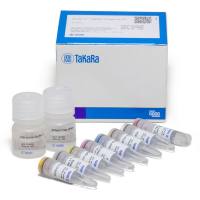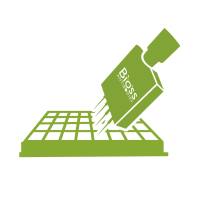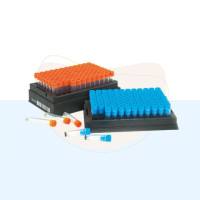Screening of recombinants
互联网
Screening of recombinants
It is best to do a test ligation without insert, if the background is low, it would not be necessary to screen colonies for insert.1) colony PCR
1) Pick a colony from plate and suspend the colony in 10 µl of 1X PCR buffer. Spot a fresh plate (divided into squares and numbered) with a drop of this suspension (or inoculate plate first then resuspend the rest in buffer). You may do as many as you wish (typically 8 - 16 colonies from each plate, therefore first prepare a suitable amount of PCR buffer, which can be then aliquoted). Incubate plate at 37°C.
2) Prepare 100 µl (or any appropriate volume) of PCR reaction mixture (with 1 ul of the enzyme added just before use).
3) Heat the cell suspension in a thermocycler to 95 °C. (Do one control reaction without any cells added for each different set of oligos)
4) Add 10 µl of the reaction mixture to the cell suspension. Then add a drop of the mineral oil.
5) Start the PCR .
6) When finished, run reaction mixture on gel.
Note :
a) For the primers, it is preferable to use one primer from the vector and one from the insert to reduce the likelihood of false positive results.
b) As in all PCR reaction, contamination giving rise to false positive is a problem. Other possible ways of reducing this are i) UV-irradiate all the solutions (except the template of course) including the primers. ii) Add DNase to all the solutions except the template - then heat the PCR reaction mixture (minus the template or in the case of colony PCR, together with the cells) to 95 °C to inactivate the DNase.
c) It seems that LB liquid media may contain substances that may inhibit the PCR reaction, therefore cells spun down from rich media will not work unless it has been washed carefully.
2) Rapid screening
1) pick cells from streaks and disperse the cells in 100 µl of QSB. Leave at room temperature for 5 minutes or until cell lysed.2) Spin at top speed for 15 minutes.
3) Load 30 - 40 µl into wells of agarose gel (load dry i.e no TAE buffer in well).
4) Run for a few mm at 300 V, then run normally (wash out wells) at 100 - 150 V.
5) Stain gel and view.
QSB(quick screen buffer)
6% glycerol1% SDS
10 µg/µl RNase A
0.002% Bromophenol blue
1X TAE
3) Another Rapid Screening Method
From D.Law and N.Crickmore at Technical tips online- Transfer the equivalent of a 1 mm diameter colony into 100 µl of pre-warmed lysis buffer (5 mM EDTA, 10% w/v sucrose, 0.25% w/v SDS, 100 mM NaOH, 60 mM KCl, 0.05% w/v bromophenol blue).
- Incubate at 37°C for 5 min.
- Place on ice for 5 min.
- Spin in a microfuge for 1 min.
- Load 20 µl onto an agarose gel.
note:
(1) lysis buffer can be frozen in 100 µl 'ready to use' aliquots;
(2) rather than using a 37°C water bath, racked samples can be placed in an incubator or hot room;
(3) rather than placing the samples on ice, they can be left in a refrigerator or cold room;
(4) plasmid DNA can be recovered from the remaining sample by phenol extraction/DNA precipitation;
(5) depending on the resolution required, the agarose gel can be pre-stained;
4) Boiling Method
Actually a modified boiling miniprep method but useful for screening large number of colonies.- Add Lysozyme/RNAse (+ BSA) STET solution to cell pellet and resuspend.
- Boil for 2 minutes.
- Spin 10 minute to pellet chromosomal DNA and cell debris.
- Supernatant can now be used for RE digest and analysis.








